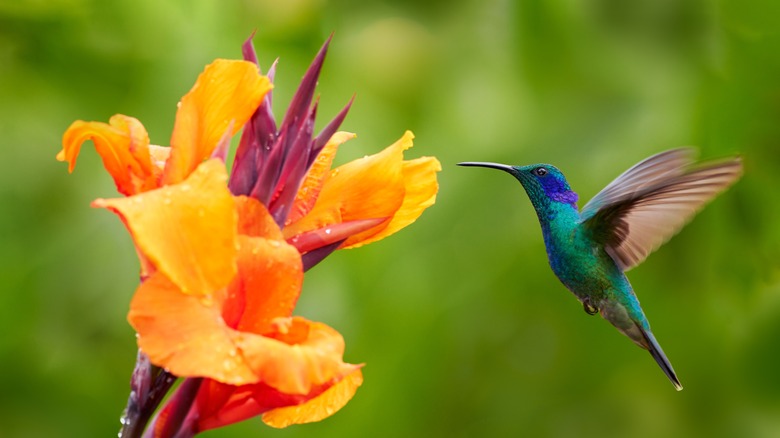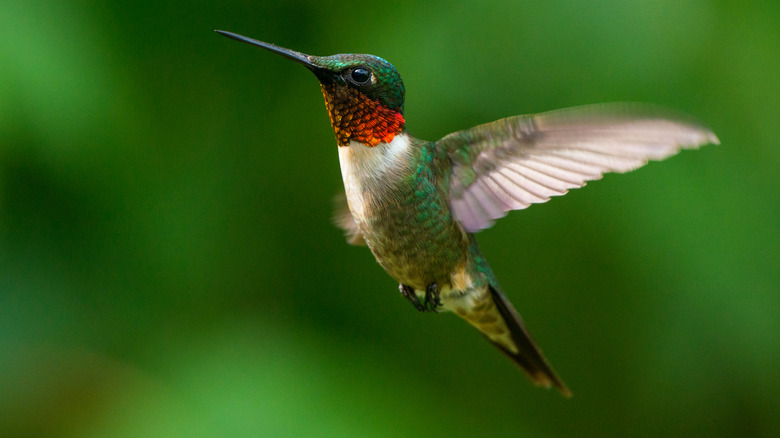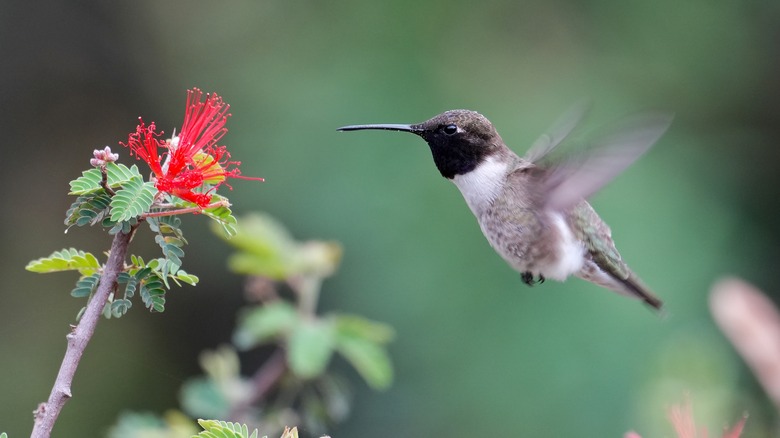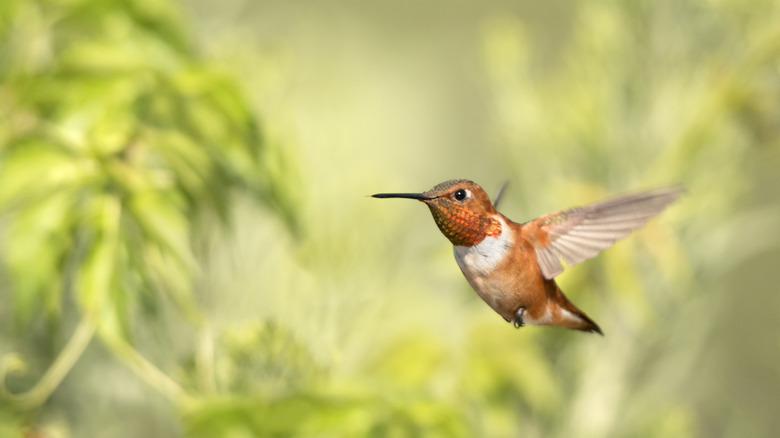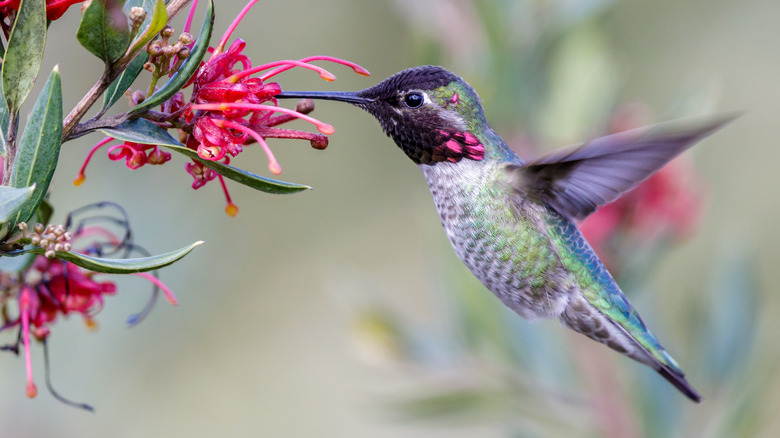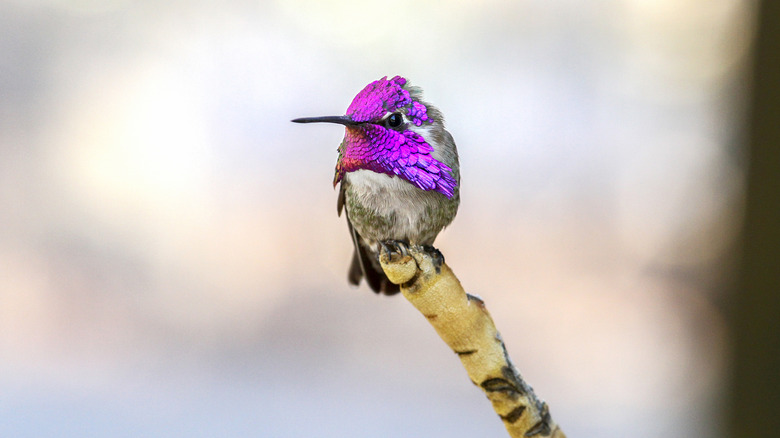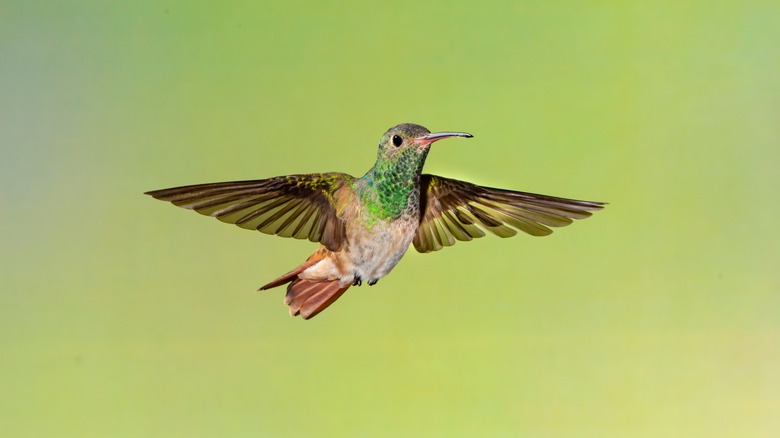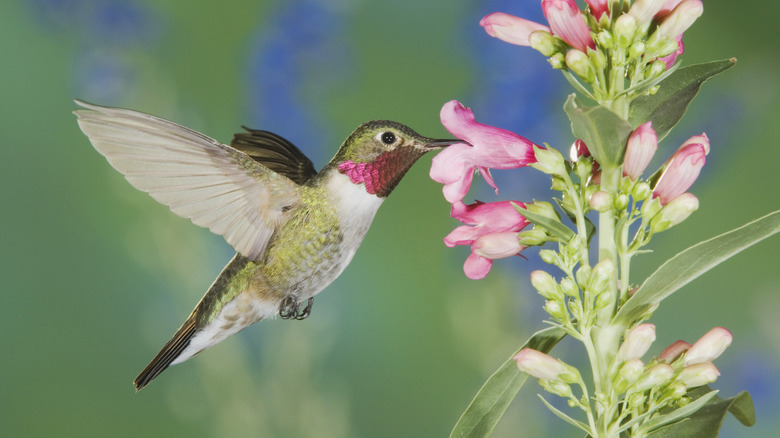7 Types Of Beautiful Hummingbirds You Might Find In Your Backyard
Hummingbirds are favored among many bird watchers and enthusiasts alike. Their small sizes, brilliant colors, and fast movements are fascinating to witness as they quickly eat nectar with their long bills to support their large calorie needs. And, if you happen to hear a hummingbird fly, you'll notice that they sound like miniature helicopters as they rapidly flap their tiny wings.
According to the National Zoo, there are more than 300 species of hummingbirds, with over a dozen that reside along the U.S./Mexico border. However, despite the variety of species, many homes in the eastern U.S. are visited by one main type of hummingbird in their backyards, while western regions might see a few varieties. Getting these colorful visitors to visit takes a bit of know-how, but there are ways to effectively attract hummingbirds to your garden and yard. Not only will you enjoy the fascinating show they put on, but you'll also feel good knowing that supporting the types of hummingbirds that visit your backyard is also critical to global pollination, per Audubon New York.
Ruby-throated hummingbirds dominate the eastern U.S.
If you live east of the Great Plains/Mississippi River, this is the type of hummingbird that will most likely visit your backyard. According to Audubon, ruby-throated hummingbirds are the only type of hummingbird that lives in the eastern U.S. However, some are also known to migrate as far north as Canada, and as far south as Costa Rica. This small bird gets its namesake due to the ruby coloring of the throats of the male. Both males and females have a variety of white, tan, and green feathers throughout their bodies.
Ruby-throated hummingbirds prefer gardens and yards that are along woods. If you have a hummingbird feeder or native pollinating flowers, chances are that these birds will stop by your yard at some point. During migration, Audubon notes that the males will fly back north during the spring sooner than females. So, if you notice a lot of male ruby-throated hummingbirds in early spring, do not fret if you don't see any females right away. Like other types of hummingbirds, ruby-throated varieties fly quickly, but they can also come to an instant stop, especially during times of feeding. They may also become territorial around food sources, including bird feeders you put out for them.
Black-chinned hummingbirds are common in western regions
While people who live east of the Mississippi River will almost exclusively see ruby-throated hummingbirds in their backyards, western regions of the U.S. may witness a few more different varieties. This includes the black-chinned hummingbird, which is known for its black, green, and white coloring, with males sporting purple throats. According to Audubon, this type of hummingbird is known to hang out in lower elevations across the region, and it's also common for this species to hang out in backyards and gardens. While the black-chinned hummingbird is commonly spotted in places like California, western Texas, and the Rocky Mountains, it's not out of the realm of possibility to see one in Florida or other areas near the Gulf Coast region. Migration may play a role here, as Audubon notes that black-chinned hummingbirds usually leave the western U.S. during the winter months.
Like many other types of hummingbirds, black-chinned species eat both nectar and insects. They can draw a show when eating the latter, as they are known to eat a single insect or several from one swarm before quickly flying back to their perches. These species are quite territorial, and the males may get aggressive during courtship as they show off to females by diving up to 100 feet at a time. Female black-chinned hummingbirds also look strikingly similar to ruby-throated species, which can make it difficult to tell them apart in your yard.
Rufous hummingbirds are among the fiercest species
Known for their small sizes and copper to orange feathers, rufous hummingbirds are among some of the more surprising hummingbirds. They spend most of the year in the Pacific Northwest region and up to Alaska. During the harsh winter months though, rufous hummingbirds migrate to south Mexico. According to All About Birds, these small birds may fly up to 4,000 miles during migration each fall, which may be the furthest for their size. And, according to Audubon, these hummingbirds have reportedly shown up in the eastern U.S. on occasion, showing that they aren't afraid to explore beyond their home regions.
While most hummingbirds guard their territories, rufous hummingbirds are among some of the fiercest of all, and they're not afraid to confront bigger animals. According to All About Birds, these hummingbirds are said to chase off larger birds, other hummingbirds, and even chipmunks! Their strong personalities and survivorship may be needed in a time where climate change might be impacting rufous hummingbirds. As Audubon explains, their numbers have declined slightly in recent years due to warming temperatures.
Anna's hummingbirds also live in the Pacific Northwest
Like rufous hummingbirds, Anna's hummingbirds are among some of the hardiest of their species. The males are identifiable by their magenta and purple heads, while the females boast different shades of green along their bodies. According to Audubon, Anna's hummingbirds are unique in that they don't tend to migrate during the winter. Instead, they live along the Pacific Northwest year-round, which may be advantageous when other types of hummingbirds leave during the cooler months. While regarded as a Pacific Northwest resident, some people living as far south as Arizona may spot these hummingbirds. Food seems to have driven this expansion, per Audubon, particularly homes in suburban areas that offer the hummingbirds nectar feeders and flowers. Some of these residents may be the few Anna's hummingbirds that migrate, which is usually westward towards California.
Aside from their general lack of migratory patterns, there are a few behaviors and features that set Anna's species apart from other types of hummingbirds. First, they're considered more vocal than other species, with males particularly prone to singing during perching. Also, according to the National Park Service, Anna's hummingbirds are also a lot less social than other types. In fact, they rarely even get along with each other, with the only exception being when females and males mating.
Costa's hummingbirds live in desert regions
Known for the purple feathers around their heads and necks, the Costa's hummingbird is one of the smallest species around. According to the American Bird Conservancy, these species have a maximum length of just 3.5 inches, which is shorter than the 4 inches of other hummingbirds. It's also thought that their small size limits their overall travel distances. While Costa's hummingbirds mostly live in the desert regions of California and Arizona, they only migrate to the northern parts of Mexico during the winter, if they leave at all. Another factor is their lack of feathers compared to other species. If they leave the warm desert, Costa's hummingbirds may not survive.
Costa's hummingbirds are threatened by urbanization, but they may still come to suburban neighborhoods. If you're trying to attract these hummingbirds to your backyard, the American Bird Conservancy suggests placing a feeder out for them as well as planting native plants in your garden. They are also under threat from Anna's hummingbirds, as the two species compete for some of the same coastal areas. You're more likely to find Costa's hummingbirds in flat regions, rather than in mountainous areas, and Audubon notes that they tend to nest in the late winter and early spring months.
Buff-bellied hummingbirds are coastal species
While most species of hummingbirds are found in the western U.S., buff-bellied hummingbirds, like ruby-throated types, are an exception. Unlike ruby-throated hummingbirds though, buff-bellied species largely reside along the Gulf coast regions, including the state of Florida. According to Audubon, this is also the only type of hummingbird to live in the southernmost regions of Texas. Outside of the United States, buff-bellied hummingbirds are widespread across the American tropics. They also get their name due to their stockier nature, and you can identify them via their variety of green, orange, and brown feathers, as well as their bright red bills.
If you live in southern Texas, you're most likely to see buff-bellied hummingbirds live and nest around your backyard during the summer months. You're more likely to see these birds in your yard if you have a lot of trees or a large garden for them to enjoy. They'll also eat from a hummingbird feeder, if you are able to put one in you yard. Just be aware that this hummingbird isn't afraid to bully other types at feeders.
Broad-tailed hummingbirds live in the western mountain regions
As perhaps one of the loudest hummingbirds when in flight, the broad-tailed hummingbird is a summer staple in the western regions of the U.S. Like the ruby-throated hummingbird, males have dark red throats and green along their bodies. Female broad-tailed hummingbirds are more distinguishable than their ruby-throated counterparts, as they have green feathers along their tops. Broad-tailed hummingbirds are primarily found around the Rocky Mountains, but they are also occasionally spotted in California, the far Northwest, and parts of the Southeast. While they are known to visit backyards in lowland regions, they can also live in areas up to 10,000 feet above sea level.
There are many beautiful varieties of hummingbirds in the western U.S. regions, and they move so fast that it can be difficult to tell them apart when they visit your backyard. Aside from the coloring of the females, one way you can tell broad-tailed hummingbirds apart from other species is by the loud buzzing sounds their wings make when they fly past. According to Audubon Rockies, this is made possible from the longest feathers on their wings. Also, due to their speed, you're more likely to see them when they feast on nectar from flowers, rather than during flight.
